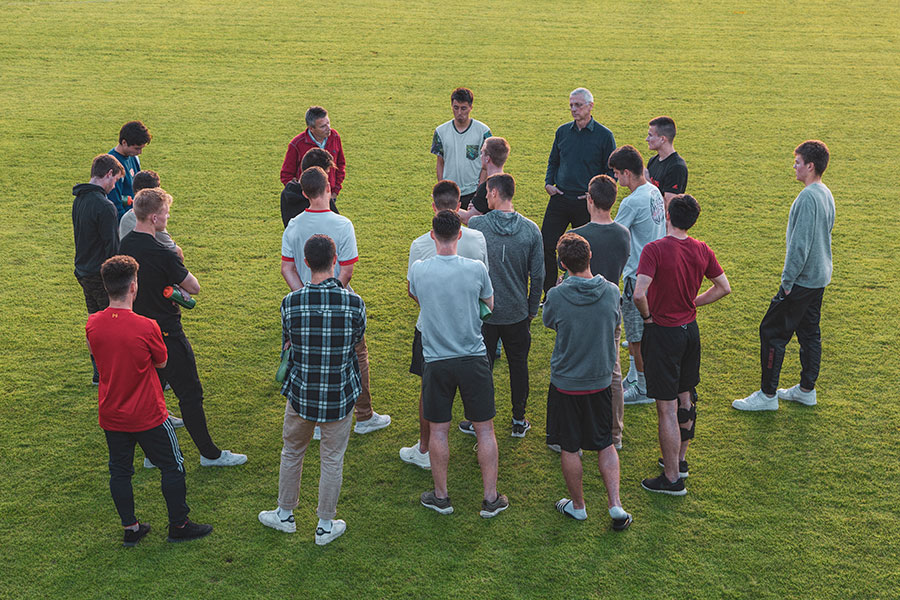The cartoon stuck on the refrigerator door of Dr. John Izzo sums up his work perfectly: Three men, wearing hard hats, eating lunch at a construction site. The caption reads, “Men working things out.” One of the co-founders of Good Men in Sport, Izzo believes it perfectly captures one of the greatest obstacles facing men today: starting a dialogue.
“Men tend to talk about problems only after they’re solved,” says Izzo, “We need to change that.”
The idea for Good Men in Sport was born out of The Men’s Initiative, an organization housed at the University of British Columbia and led by Dr. David Kuhl and Dr. Duncan Shields, along with Izzo. Understanding how the power of sport could enable them to do more significant transitional work with men in need, they developed Good Men in Sport to spark a global conversation about the daily practice of being a better man.
Central to the initiative: Not shaming men but rather sharing their stories.
“It’s been proven that shaming doesn’t work when it comes to behavior change because, at our core, no one wants to be told what to do, especially men,” says Izzo. “But sharing stories of how we aspire to be better men and the hard choices that come with working to become better people, those are the moments that can create real movement.”
To accelerate the impact of the program, the founders engaged athletes to champion the initiative. Izzo explains that the role of these athletes is to be permission-givers — individuals who give others permission to act in a certain way. Eight Good Men in Sport champions have already been signed up, including Nathan Adrian, five-time Olympic swimming gold medalist, Austin Bold, Amobi Okugo, and Blaine Scully, captain of the U.S. Men’s Rugby Team. With the influence that sports stars have in today’s hyperconnected work, it’s no surprise that world-class athletes play a central role.

Athletes are essential permission-givers and role models for both adult and younger men, who often see them as heroes. According to The Men’s Initiative, almost 50 percent of boys spend part of their childhood without a father or male role model. Izzo believes athletes can help model positive behavior by embracing a fuller form of masculinity.
In addition to its champions, Good Men in Sport has gone straight to the top and identified high-profile institutions and teams to work with. Aspirational masculinity programs have been introduced in the Stanford men’s soccer team, Stanford Athletics coaching staff and Atlanta Falcons rookies. A research project called “Men In Sport” in conjunction with Promundo, the world’s leading experts on masculinity, aims to understand the issues men in sport face around masculinity.
“Men Are Suffering”
In addition to encouraging men to embrace their masculinity more positively, Izzo also wants to raise awareness around the fact that men are suffering, and works off the simple premise that “hurt people hurt people.”
There are amazing fathers, husbands, and colleagues out there, but sometimes they’re not very engaged in family life, and often absent. There are less obvious ways that men have caused suffering — from a lack of inclusion, patriarchal attitudes and even the general state of the world, through a lack of sustainability-minded thinking, an obsession with fast growth and competition for competition’s sake.
“Men contribute to the suffering of men, and this leads to substance abuse, poor relationships with their kids, fewer friendships, and a feeling of isolation from female counterparts. It’s not like men and women are radically different. But there are meaningful differences that we should be aware of, and work to change,” says Izzo.
According to Izzo, there are two opposing views currently making the rounds about men in the modern world. The first assumes men have screwed things up, and they need to fix it. The second is that men have been screwed and have had their rights taken away, so they need to reassert themselves. Izzo believes neither outlook is constructive.

A question asked for decades has been the extent genetic DNA plays in a man’s behavior, versus how society and socialization have shaped them.
The study of epigenetics, a field of biology that examines the heritage of our DNA, suggests that the quality of nurture is hardwired into both male and female. One solution Izzo offers is that men and women can work better together when they reflect and think more about the choices they make. “As an advanced species, we should be able to override biological tendencies and base our relationship more on logical thought,” he says.
Yet, ignoring deeply ingrained instincts can be difficult for many men.
Izzo recalled an experience he once had in a society that still subscribes to clear-cut gender roles. In Tanzania a few years ago, he joined a hunting party in a tribe that still lives as our ancestors did, before the agricultural revolution. He spent the entire day not speaking to the men he was hunting with. “Basically, talking gets in the way of effective hunting. If you’re a woman or older man in that society, you stay home and do other, equally important things that require lots of interaction. You might argue that, over time, these attributes became part of our biology.”
Izzo is quick to point out that this shouldn’t make us prisoners of nature. To counterpoint his hunting story, he tells of a female anti-poaching team in Zimbabwe, that has had massive success in conserving wildlife that is being slaughtered for ivory. The women are in the bush all day with automatic weapons wearing camouflage, hunting down poachers. It’s a reminder that a role doesn’t have to be defined by gender if you allow it.
One of the first things Izzo does when he stands within a circle of men at a workshop of Good Men in Sport is to list all the things a man has been defined to be — strong, independent and silent. “All these attributes can be beneficial, but problems arise when men can’t engage in their full range of human emotions,” he explains. “Men also need to know it’s okay to be weak, ask for help or to be vulnerable.”
On the flip side, women have also been painted with traditional personality traits that have constrained them. Women were frowned upon if they were assertive, dissuaded from being ambitious and weren’t expected to be physically strong.
“We’ve worked hard over the past 30 years to allow women to play within the full range of human emotions, now we have to work equally hard on men,” says Izzo. “Women have the glass ceiling to break through, men have the nursery door closed on them.”
Many may think, “Nice try guys, but I’m not falling for centuries of patriarchy that you now want to unwind, all while painting yourselves the victims.” It’s a valid opinion that Izzo and his team are only too aware of. His approach is to ignore the volatile battle of the sexes and focus on what we all have to gain by changing our attitudes.
“Think of an airplane with two wings,” he says. “It won’t fly unless it has both; male and female. So many resources have been allocated to the upliftment of women and girls but developing that other (male) wing will help the whole airplane. Men also need to step up to help other men achieve this.”
In 1994 Izzo attended the U. N. Conference on Population and Development in Cairo. Everything he heard was around helping the development of young women: If young women had opportunities and education, the economy grew, families became stronger, populations declined. Twenty-four years later, many of these ideas have been widely implemented, and much progress has been achieved. “But no one has considered what we need to do with men,” says Izzo. A friend of his approached the United Nations to start a program for young men in Tanzanian schools around becoming better men. Thinking there must be an existing program he was shocked to discover it had never been done before. He was asked why he even wanted to attempt it, as the focus was on women.
“Yes, we need to work on women’s issues and empowerment, but you can’t work with half the system,” says Izzo. “Imagine the increased success of these programs if men are included.”




































